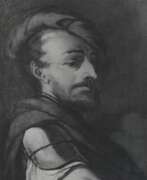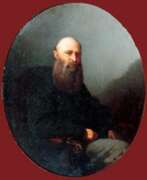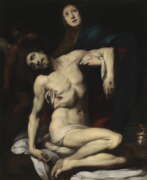Portraitist Italian school


Francesco Faraone Aquila was an Italian engraver. In 1690 he moved to Rome where his brother Pietro had been an engraver for several decades in major workshops in the capital. Pope Clement XI gave him an order which has remained his main work - engraving the bas-reliefs of the Antoninus Pius column and its pedestal. Another important work by Francesco Aquila is the engraving of the frescoes of the dome of the Cathedral of Parma by Correggio and the painting of the Vatican chambers. Following the antique taste established in the 18th century, Aquila engraved various Roman classical works: statues, vases and triumphal arches, thus satisfying the demand of mainly foreign visitors, mainly German and English. His portraits of his contemporaries, both painters and clergymen, also enjoyed great popularity.


Carlo Cannovaro Caliari was an Italian artist of the Renaissance period. He is also known as Carletto. The youngest son of Paolo Veronese, Caliari was active mainly in Venice, where he worked and inherited the studio of his far more famous father, and later worked along with his brother Gabriele and his uncle, Benedetto.


Giulio Carpioni was an Italian Baroque painter, etcher, and a significant figure in the early Baroque period, primarily associated with Venice and Vicenza. His artistic journey began under the mentorship of Alessandro Varotari, known as Il Padovanino. Carpioni's work was influenced by various artists and styles, including the realism and objectivity characteristic of Saraceni and Jean Leclerc, as well as Lombard painting, which he encountered during a trip to Bergamo.
Giulio Carpioni's oeuvre includes a mix of religious and mythological subjects, demonstrating a penchant for narrative and allegory, often depicted with a distinctive graphic line and a warm tonal palette. Noteworthy works include the Apotheosis of the Dolfin family and the Allegory of the Grimani Family, showcasing his ability to blend mythological themes with a vibrant expression of Baroque aesthetics.
His bacchanal scenes, such as the one described in a detailed analysis on the Museo Nacional Thyssen-Bornemisza's website, exhibit his skill in composition and use of color to create dynamic, engaging scenes. Giulio Carpioni's influence extended through his etchings and collaborative works, contributing significantly to the art culture of his time.
For collectors and art enthusiasts interested in Carpioni's work, staying informed about exhibitions, sales, and auctions is essential. Signing up for updates can provide access to the latest information on Giulio Carpioni's pieces, ensuring you don't miss out on new discoveries or opportunities to add to your collection.


Romuald Chojnacki was a mid-nineteenth-century Russian artist of Polish descent. He is known as a painter and teacher.
Romuald Chojnacki was a follower of the Italian school of painting. He worked mainly in portrait and religious genres. At the beginning of his career, he also created historical paintings and returned to this genre shortly before his death.
The master was one of the founders of the Odessa Drawing School. Among his pupils was the famous Polish artist Stanisław Chlebowski.


Daniele Crespi was an Italian painter and draughtsman. He is regarded as one of the most original artists working in Milan in the 1620s. He broke away from the exaggerated manner of Lombard Mannerism in favour of an early Baroque style, distinguished by clarity of form and content. A prolific history painter, he was also known for his portraits.


Bartolomeo Nazari was an Italian painter and printmaker of the academic Venetian Baroque school. He studied painting with Angelo Trevisani and later became assistant to Francesco Trevisani and Benedetto Luti.
Bartolomeo Nadzari was a famous portrait painter of his time. He produced numerous pictorial works depicting prominent figures, among them Canaletto, Francesco Correra, Cardinal Vincenzo Querini, the procurators Alvise Mocenigo, Nicolo Veniera, Zaccaria Canal and Lorenzo Morosini. Particularly famous is the life-size equestrian portrait of Marshal Johann Matthias von der Schulenburg. In 1744 Nadzari was in Frankfurt where he painted a portrait of Emperor Charles VII.







